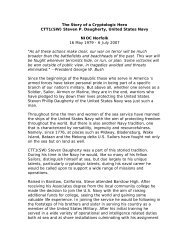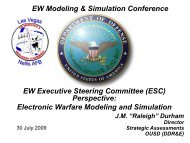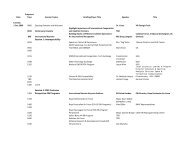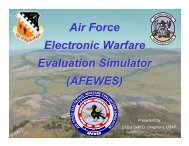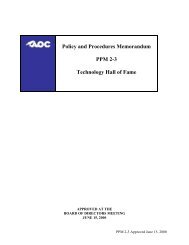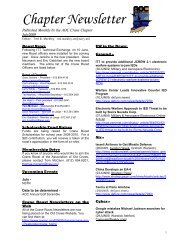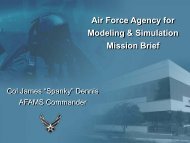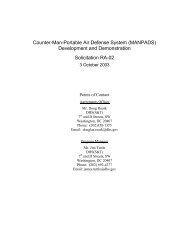statement of honorable donald c. winter secretary of the navy
statement of honorable donald c. winter secretary of the navy
statement of honorable donald c. winter secretary of the navy
- No tags were found...
Create successful ePaper yourself
Turn your PDF publications into a flip-book with our unique Google optimized e-Paper software.
NOT FOR PUBLICATIONUNTIL RELEASED BY THEHOUSE ARMED SERVICES COMMITTEESTATEMENT OFHONORABLE DONALD C. WINTERSECRETARY OF THE NAVYBEFORE THEHOUSE ARMED SERVICES COMMITTEE6 MARCH 2008NOT FOR PUBLICATIONUNTIL RELEASED BY THEHOUSE ARMED SERVICES COMMITTEE
The Secretary <strong>of</strong> <strong>the</strong> Navy’s FY 2009 Posture StatementThe Navy and Marine Corps Team…fighting today and preparing for futurechallengesI. IntroductionChairman Skelton, Congressman Hunter and Members <strong>of</strong> <strong>the</strong> Committee, it is an honor toappear again before you representing <strong>the</strong> men and women <strong>of</strong> <strong>the</strong> United States Navy and <strong>the</strong>United States Marine Corps—active, reserve, and civilian—a force <strong>of</strong> over 800,000 strong.I am here to present <strong>the</strong> Department <strong>of</strong> <strong>the</strong> Navy’s (DON) plan to support our Sailors andMarines in <strong>the</strong>ir mission to defend our Nation against current and future challenges as <strong>the</strong>yconduct operations spanning <strong>the</strong> spectrum, from major combat to humanitarian assistance. ThePresident’s Fiscal Year (FY) 2009 Budget will assist <strong>the</strong> Navy and Marine Corps inaccomplishing <strong>the</strong>ir complimentary and reinforcing missions, while building capabilitiesnecessary to meet future threats. The FY 2009 budget balances capabilities to support bothtraditional and irregular warfare demands. It also continues to expand <strong>the</strong> Marine Corps’capacity and fur<strong>the</strong>rs <strong>the</strong> transformation from a blue water <strong>navy</strong> into one that can fight and winin <strong>the</strong> blue, green, and brown waters.As I reflect upon my time as Secretary <strong>of</strong> <strong>the</strong> Navy, nothing is more sobering than <strong>the</strong>experience <strong>of</strong> seeing—every single day—<strong>the</strong> dedication, pr<strong>of</strong>essionalism, and willingness tosacrifice shown by our Sailors, Marines, civilian employees, and <strong>the</strong>ir families. I will attest toyou <strong>the</strong>ir unwavering commitment to duty. These patriots put <strong>the</strong>mselves in harm’s way toprotect our Nation. From those who have given <strong>the</strong> ultimate sacrifice, such as Medal <strong>of</strong> Honorrecipients Lieutenant Michael Murphy and Corporal Jason Dunham, to those who daily take <strong>the</strong>pledge to support and defend our Nation, our Navy and Marine Corps Team is second to none. Itis because <strong>of</strong> <strong>the</strong>ir efforts that we are making progress fostering maritime security, defeatingterrorist networks, progressing towards a stable Iraq, supporting <strong>the</strong> Afghan government,countering piracy and <strong>the</strong> proliferation <strong>of</strong> deadly technology, giving humanitarian assistance topeople in need after Tsunamis and earthquakes, and streng<strong>the</strong>ning partnerships around <strong>the</strong> world.The men and women <strong>of</strong> <strong>the</strong> Navy and Marine Corps have responded when called upon. It is anhonor and privilege to work with <strong>the</strong>m and support <strong>the</strong>m as <strong>the</strong>ir Secretary.Today our Nation is faced with a myriad <strong>of</strong> challenges and uncertainties across <strong>the</strong> globe.There have been several unexpected, and sometimes sudden, changes in <strong>the</strong> security environmentover <strong>the</strong> past few years. Yet many <strong>of</strong> <strong>the</strong> strategic imperatives <strong>of</strong> <strong>the</strong> United States—particularlywith respect to <strong>the</strong> maritime environment—remain unchanged. It is clear <strong>the</strong> United States musthave <strong>the</strong> capacity to act in such a fluid and unpredictable environment, and that Naval forces<strong>of</strong>fer unique flexibility to respond swiftly and decisively anywhere in <strong>the</strong> world. Providing thisflexibility requires that <strong>the</strong> Department <strong>of</strong> <strong>the</strong> Navy invest wisely across a wide range <strong>of</strong>capabilities, and that we take care to deliver a balanced portfolio <strong>of</strong> capabilities to <strong>the</strong> Joint force.2
Worldwide presence, credible deterrence and dissuasion, projection <strong>of</strong> power from navalplatforms anywhere on <strong>the</strong> globe, and <strong>the</strong> ability to prevail at sea are <strong>the</strong> critical, mostfundamental elements <strong>of</strong> <strong>the</strong> Navy and Marine Corps strategic posture; <strong>the</strong>se are ourindispensable contributions to <strong>the</strong> joint warfighting capability <strong>of</strong> <strong>the</strong> Nation.The United States is a maritime power, bounded by sea to <strong>the</strong> east and west. The health <strong>of</strong> ournational economy depends on assuring safe transit through <strong>the</strong> seas—and <strong>the</strong> maritimedimension <strong>of</strong> international commerce is ever increasing. Consider that 70 percent <strong>of</strong> <strong>the</strong> earth iscovered by water, 80 percent <strong>of</strong> <strong>the</strong> world’s population lives in close proximity to <strong>the</strong> coast, and90 percent <strong>of</strong> <strong>the</strong> world’s international commerce is transported via <strong>the</strong> sea. Given our nationalinterests, and <strong>the</strong> role we play in <strong>the</strong> world, it is unsurprising that our Sailors and Marines areconstantly called upon to react to a wide range <strong>of</strong> challenges. I suggest that <strong>the</strong> strength <strong>of</strong> anation’s naval force remains an essential measure <strong>of</strong> that nation’s status and role in <strong>the</strong> world. Ialso submit that maritime dominance by <strong>the</strong> United States remains vital to our national security,to our position in <strong>the</strong> world, and to our ability to defend and promote our interests.Last fall, <strong>the</strong> Department <strong>of</strong> <strong>the</strong> Navy, in collaboration with <strong>the</strong> U.S. Coast Guard, reaffirmedits emphasis on <strong>the</strong> traditional capabilities <strong>of</strong> forward presence, deterrence, sea control, andpower projection in its new Maritime Strategy: A Cooperative Strategy for 21 st CenturySeapower. However, <strong>the</strong> Maritime Strategy also makes clear that we consider our corecapabilities to include maritime security and <strong>the</strong> provision <strong>of</strong> humanitarian assistance anddisaster relief—areas <strong>of</strong> growing importance. The strategy emphasizes <strong>the</strong> use <strong>of</strong> s<strong>of</strong>t power,and highlights <strong>the</strong> criticality <strong>of</strong> our foreign friends and allies, while reminding us that <strong>the</strong>underlying credibility for partnerships and peace is <strong>the</strong> United States’ ability to swiftly defeat athreat with overwhelming and decisive combat power.The unique nature <strong>of</strong> our Department is such that <strong>the</strong> Navy and Marine Corps team is aconstantly deployed force, both in peacetime and in war, with <strong>the</strong> fur<strong>the</strong>r ability to surge assetsworldwide, anytime required. As we consider <strong>the</strong> current and projected strategic environment,we must anticipate a steadily growing reliance on our unique expeditionary character. This isbecoming ever more apparent. The challenge <strong>of</strong> resourcing our two services across such a largerange <strong>of</strong> steadily growing global missions, from partnership building to combat operations, isone that we have met with <strong>the</strong> President’s FY 2009 Budget.Reflected in <strong>the</strong> Budget submittal is <strong>the</strong> fact that today’s Navy and Marine Corps areoperating in blue, green and brown waters, in <strong>the</strong> air and on <strong>the</strong> shore—and sometimes deepinland—facing a wide variety <strong>of</strong> threats. On any given day, approximately 40 percent <strong>of</strong> <strong>the</strong>fleet is deployed at sea or involved in pre-deployment training. Forward deployed carrier andexpeditionary strike groups operate on <strong>the</strong> high seas, unencumbered by constraints facing landbasedforces. They are providing our combatant commanders with many important and powerfulcombinations <strong>of</strong> capability: tactical aviation, land attack systems, SEAL and Marine specialoperations forces (SOF), intelligence and surveillance platforms, amphibious assault and forcibleentry capacity, over-<strong>the</strong>-horizon force projection, and flexible seabasing and at sea logisticalsupport. Our full spectrum <strong>of</strong> capabilities also includes ship-based ballistic missile defense—providing a shield that not only protects our maritime freedom <strong>of</strong> movement and access, but3
which also contributes to <strong>the</strong> defense <strong>of</strong> our allies and our homeland against missile threats. Ino<strong>the</strong>r words, we are presenting a budget which supports a force in high demand across <strong>the</strong> globe.The President’s Budget does more than just fulfill our responsibilities in today’s complexenvironment; it continues to evolve our portfolio <strong>of</strong> capabilities. This is essential to our ability todefend against future threats which could range from <strong>the</strong> asymmetric—from terrorists toproliferation and/or use <strong>of</strong> weapons <strong>of</strong> mass destruction—to <strong>the</strong> more traditional challengesposed by nation-states and possible future “near peer” competitors.Evolving our portfolio <strong>of</strong> capabilities can be challenging, since <strong>the</strong> Navy and Marine Corpshave an operational construct that emphasizes forward deployment and presence. Historically,while <strong>the</strong> bulk <strong>of</strong> U.S. forces return home after cessation <strong>of</strong> a conflict or crisis, our maritimeforces <strong>of</strong>ten do not. They are continuously present in forward regions, and through <strong>the</strong>ir forwardengagement <strong>the</strong>y maintain familiarity with <strong>the</strong> environment and <strong>the</strong> characteristics <strong>of</strong> regionalactors; <strong>the</strong>y also foster and sustain trust and cooperation with friends and allies. Thus when athreat to our national security emerges overseas, it may well be encountered first by <strong>the</strong> Navyand Marine Corps. Meeting that threat, whe<strong>the</strong>r on land, in <strong>the</strong> air, on <strong>the</strong> high seas, or under <strong>the</strong>sea, will require our forces to be in peak fighting condition. They must be ready to fight and winat any time, and to do so at great strategic distance. We have developed a budgetary plan whichaddresses <strong>the</strong>se requirements.We have developed <strong>the</strong> budget in <strong>the</strong> face <strong>of</strong> a demanding and rapidly changing securityenvironment, and <strong>the</strong>re are worrisome trends that bear watching. Nations are developingweapons and systems which seem deliberately intended to threaten our Naval assets, deny access,and restrict our freedom <strong>of</strong> maneuver. The proliferation <strong>of</strong> anti-access weapons technology tounfriendly nations is a significant concern. Fur<strong>the</strong>rmore, <strong>the</strong> Department <strong>of</strong> <strong>the</strong> Navy, like o<strong>the</strong>rparts <strong>of</strong> <strong>the</strong> Department <strong>of</strong> Defense (DoD), has been a target <strong>of</strong> aggressive foreign intelligenceand data-collection activities. As such, we need to invest in <strong>the</strong> capabilities necessary topreserve our technological advantage. Additionally, aside from growing costs and scheduledelays in some acquisition programs, we also struggle with regulatory encroachment and legalchallenges that threaten to undercut our ability to effectively train and maintain readiness. Wemust address <strong>the</strong>se challenges; doing so is fundamental to maintaining our Naval readiness andour capability to defend our Nation.In summary, <strong>the</strong> Department <strong>of</strong> <strong>the</strong> Navy’s FY 2009 budget invests in <strong>the</strong> Navy and MarineCorps to operate, sustain and develop forces that will remain engaged in <strong>the</strong> Global War onTerrorism (GWOT), while at <strong>the</strong> same time preparing <strong>the</strong> force for <strong>the</strong> challenges and threats <strong>of</strong><strong>the</strong> future. The FY 2009 budget requests $149.3 billion for <strong>the</strong>se purposes. This is a 7 percentincrease over <strong>the</strong> FY 2008 baseline and is driven by factors such as rising oil costs and <strong>the</strong>critical, comprehensive growth <strong>of</strong> <strong>the</strong> United States Marine Corps.Priorities for <strong>the</strong> Department <strong>of</strong> <strong>the</strong> NavyThe Department <strong>of</strong> <strong>the</strong> Navy is committed to finding solutions that allow <strong>the</strong> Navy andMarine Corps to balance our current requirements and operational realities with <strong>the</strong> likely needs<strong>of</strong> <strong>the</strong> future. We strive to maintain an agile and flexible force that can not only contribute to4
winning our Nation’s wars but also can assist in preventing future conflict to <strong>the</strong> extentpossible—whe<strong>the</strong>r by dissuasion, deterrence, humanitarian action or disaster relief. As such,our priorities remain consistent with those in previous years. They are to:• Prevail in <strong>the</strong> GWOT;• Take care <strong>of</strong> our Sailors, Marines, <strong>the</strong>ir Families and particularly our wounded; and• Prepare for future challenges across <strong>the</strong> full spectrum <strong>of</strong> operations.As in <strong>the</strong> past, for <strong>the</strong> sake <strong>of</strong> brevity, some <strong>of</strong> <strong>the</strong> key programs are highlighted and can befound in greater detail in <strong>the</strong> Highlights <strong>of</strong> <strong>the</strong> Department <strong>of</strong> <strong>the</strong> Navy FY 2009 Budget. 1 This<strong>statement</strong> is designed to reinforce, and build upon, initiatives articulated in previous testimonyand budget material.II. Prevail in <strong>the</strong> Global War on TerrorismThe Department’s top priority remains <strong>the</strong> Global War on Terrorism. Today, approximately29,300 Marines and 11,300 Sailors (including individual augmentees) operate ashore, along with12,000 Sailors at sea. They are conducting and supporting operations in Iraq and Afghanistan,and throughout <strong>the</strong> U.S. Central Command region, and <strong>the</strong>ir contributions are central to <strong>the</strong>progress being made.Naval forces provide a major part <strong>of</strong> <strong>the</strong> national worldwide rotational presence and anincreasing portion <strong>of</strong> <strong>the</strong> required support for ground units in OPERATION ENDURINGFREEDOM (OEF) and OPERATION IRAQI FREEDOM (OIF). They operate across <strong>the</strong>spectrum—from low intensity conflict, humanitarian assistance and disaster relief, to highintensity conflict involving airborne strike and Marine Corps forces in coordinated joint andcoalition ground operations. To illustrate <strong>the</strong> wide range <strong>of</strong> activities undertaken, it isnoteworthy that, in 2007, five Carrier Strike Groups and five Expeditionary Strike Groupsdeployed in support <strong>of</strong> OEF and OIF. Throughout 2007 <strong>the</strong> Marine Corps provided threeembarked Marine Expeditionary Units (MEUs) forward positioned in all geographic commands.Two <strong>of</strong> <strong>the</strong>se MEUs were employed ashore in support <strong>of</strong> Multi-National Force-West andparticipated in sustained combat operations. Naval aviation, afloat and ashore, in concert withU.S. Air Force and coalition aviation forces, has provided critical strike, overland surveillance,logistical and electronic warfare support to <strong>the</strong> joint land forces deployed in Iraq and Afghanistan.The Navy has also deployed riverine forces for <strong>the</strong> first time since Vietnam, operating on LakeThar Thar and <strong>the</strong> Euphrates River. The Marine Corps also achieved a milestone with successfuldeployment <strong>of</strong> <strong>the</strong> first MV-22 Osprey squadron in OIF operations. Naval Special Warfare(NSW) forces continue to be actively engaged in combating terrorism. The Navy SEALs and <strong>the</strong>Marine Special Operations Command have done outstanding work in OIF/OEF and have madecritical progress in countering <strong>the</strong> threat <strong>of</strong> international terrorism. We will continue to prioritizeinvestment and retention <strong>of</strong> our highly skilled special operations forces.In addition to traditional types <strong>of</strong> maritime activities, <strong>the</strong> Navy continues to support <strong>the</strong>GWOT in a variety <strong>of</strong> non–traditional areas. For example, Navy Sailors are leading a number <strong>of</strong>1 Highlights <strong>of</strong> <strong>the</strong> Department <strong>of</strong> <strong>the</strong> Navy FY 2009 Budget, February 2008.5
Provincial Reconstruction Teams in Afghanistan today. Significant numbers <strong>of</strong> Naval combatsupport and combat service support personnel are relieving <strong>the</strong> Army and Marine Corps in selectmission areas. In U.S. Central Command, Navy personnel are providing base and portoperations support, medical, explosive ordinance disposal, construction battalions, civil affairs,electronic warfare, mobile security forces, detainee operations, intelligence, and headquartersstaff support. The Navy also continues command <strong>of</strong> <strong>the</strong> detainee mission in Guantanamo Bay,Cuba and at Camp Bucca, a high security prison in Iraq. Executive agent responsibilities aredischarged by <strong>the</strong> Navy for <strong>the</strong> GWOT-related Combined Joint Task Force Horn <strong>of</strong> Africa (CJTFHOA) in Djibouti. CJTF HOA has transformed from its initial seafaring force, aimed atblocking terrorists fleeing Afghanistan (and preventing <strong>the</strong>m from establishing new safe havens),into a task force that also conducts military-to-military training and humanitarian assistance overa large geographic expanse <strong>of</strong> eight countries.With respect to <strong>the</strong> Marine Corps, <strong>the</strong> II Marine Expeditionary Force Forward, augmented byMarines from around <strong>the</strong> Corps, conducted counterinsurgency operations in Iraq and led <strong>the</strong> Multi-National Force-West in Al Anbar Province, supported by Army, Air Force, and Navy personnel.The achievements <strong>of</strong> <strong>the</strong> Marines in Al Anbar have been widely noted, and <strong>the</strong>ir success increating a permissive environment for local governance and economic development—makingsignificant inroads in security, training, and transfer <strong>of</strong> responsibility to <strong>the</strong>ir Iraqi counterparts—has been crucial. More broadly across <strong>the</strong> country, Marine Corps Transition Teams haveconducted training for Iraqi military, police and border teams. The Marine Corps provided over800 personnel across more than 50 types <strong>of</strong> Iraqi transition teams in 2007. Building upon <strong>the</strong>sesuccesses in Iraq, recently <strong>the</strong> President approved <strong>the</strong> deployment <strong>of</strong> 2,200 Marines to Afghanistanin support <strong>of</strong> <strong>the</strong> NATO-led International Security Assistance Force mission, and 1,000 Marines toassist in <strong>the</strong> training and development <strong>of</strong> <strong>the</strong> Afghan National Security Forces. In preparation for<strong>the</strong>se overseas missions, <strong>the</strong> Marine Corps continues to implement comprehensive trainingprograms at home, such as Mojave Viper and Desert Talon.At sea, <strong>the</strong> effective conduct <strong>of</strong> Maritime Security Operations is a critical element <strong>of</strong> <strong>the</strong> fightagainst terrorism. In <strong>the</strong> Nor<strong>the</strong>rn Arabian Gulf, our Sailors and Marines are working withCoalition and Iraqi forces in a Coalition Task Group to defend <strong>the</strong> Al Basra Oil Terminal and <strong>the</strong>Khawr al Amaya Oil Terminal. The security <strong>of</strong> <strong>the</strong>se platforms is provided through waterbornepatrols in Rigid Hull Inflatable Boats, platform security personnel, and helicopter surveillance.Working with our NATO Allies, <strong>the</strong> Navy continues to provide support for OPERATIONACTIVE ENDEAVOR, which is an ongoing maritime interdiction effort in <strong>the</strong> Mediterranean.Similarly, <strong>the</strong> conduct <strong>of</strong> operations to dissuade and counter piracy <strong>of</strong>f <strong>the</strong> West African coastand <strong>the</strong> actions <strong>of</strong> <strong>the</strong> guided missile destroyers USS PORTER, USS ARLEIGH BURKE andUSS JAMES E. WILLIAMS <strong>of</strong>f <strong>the</strong> coast <strong>of</strong> Somalia this past October are examples <strong>of</strong> how <strong>the</strong>Navy is working to provide a secure maritime environment.Fostering enduring foreign partnerships and friendships is yet ano<strong>the</strong>r key contributor to <strong>the</strong>GWOT, as we bolster <strong>the</strong> capacity <strong>of</strong> nations to work with us, and to conduct counter-terrorismefforts <strong>of</strong> <strong>the</strong>ir own. The Navy is continuing to develop <strong>the</strong> concept <strong>of</strong> Global Fleet Station(GFS), envisioned to be a highly visible, positively engaged, reassuring, and persistent sea basefrom which to interact with <strong>the</strong> global maritime community <strong>of</strong> nations. The Departmentdemonstrated <strong>the</strong> concept through <strong>the</strong> GFS pilot in October, using <strong>the</strong> HSV-2 SWIFT in <strong>the</strong>6
Caribbean, and again with <strong>the</strong> African Partnership Station in <strong>the</strong> Gulf <strong>of</strong> Guinea, using <strong>the</strong> USSFORT MCHENRY and HSV-2 SWIFT. In addition to targeted outreach activities, <strong>the</strong> Navy andMarine Corps team extends America’s diplomatic reach through <strong>the</strong> conduct <strong>of</strong> multinationalexercises and port visits. Throughout 2007, <strong>the</strong> Naval force participated in over 230 bilateral andmultinational exercises with partners around <strong>the</strong> globe. 2 The Marine Corps also participated inover sixty Theater Security Cooperation events, which ranged from deployment <strong>of</strong> small MobileTraining Teams in Central America to MEU exercises in Africa, <strong>the</strong> Middle East, and <strong>the</strong>Pacific. Additionally, several overseas training events were held with foreign special operationsforces to improve interoperability with Navy and Marine SOF, and <strong>the</strong> Department providedsupport to <strong>the</strong> stand-up <strong>of</strong> NATO’s new SOF Coordination Center. The cumulative effect <strong>of</strong><strong>the</strong>se exercises and events is to foster trust and sustain cooperative relationships with ourinternational partners. This is critical to U.S. national security.Outreach to foreign populations is also an important part <strong>of</strong> <strong>the</strong> Nation’s efforts to stem <strong>the</strong>spread <strong>of</strong> terrorism. This is an important mission for <strong>the</strong> Navy and <strong>the</strong> Marine Corps and is atangible way that we can demonstrate <strong>the</strong> compassion and values <strong>of</strong> <strong>the</strong> American people. Lastyear, <strong>the</strong> Navy and Marine Corps toge<strong>the</strong>r were at <strong>the</strong> forefront <strong>of</strong> numerous humanitarianassistance and disaster relief operations. Sailors and Marines in <strong>the</strong> Pacific provided desperatelyneededhumanitarian support to Bangladesh in <strong>the</strong> aftermath <strong>of</strong> Cyclone Sidr. The Marine Corpsengaged in civil-military and humanitarian assistance operations such as “New Horizons” inNicaragua and land mine removal training in Azerbaijan. The joint and combined crew aboard<strong>the</strong> USNS COMFORT gave humanitarian aid during a four month tour in Latin America and <strong>the</strong>Caribbean. During Pacific Partnership 2007, <strong>the</strong> joint and interagency crew <strong>of</strong> <strong>the</strong> USSPELELIU gave similar aid to <strong>the</strong> Philippines and o<strong>the</strong>r Pacific island nations. We hope that <strong>the</strong>support given during <strong>the</strong>se missions, whe<strong>the</strong>r it was <strong>the</strong> Seabees’ reconstruction <strong>of</strong> homes andschools devastated by a tsunami, or inoculation and treatment <strong>of</strong> children and <strong>the</strong> elderly byNavy and Marine medical pr<strong>of</strong>essionals, helped convey a positive image <strong>of</strong> <strong>the</strong> United Stateswith local populations.Finally, within <strong>the</strong> United States, <strong>the</strong> Department continues its emphasis on providingincreased force protection to our Sailors and Marines, particularly in <strong>the</strong> area <strong>of</strong> counterimprovisedexplosive devices (IED). As lead service for <strong>the</strong> joint Mine Resistant AmbushProtected (MRAP) vehicle program, <strong>the</strong> Department accelerated production for MRAP vehiclesto rapidly field this capability in Iraq and Afghanistan. Through <strong>the</strong> use <strong>of</strong> Lean Six Sigmaactivities and projects, <strong>the</strong> Department synchronized an effort to build and transport MRAPvehicles to <strong>the</strong> <strong>the</strong>ater, rapidly identifying and mitigating deficiencies in <strong>the</strong> MRAP vehiclepipeline. Over 2,000 MRAP vehicles have been fielded to support <strong>the</strong> Department’s joint urgentrequirement, over 900 <strong>of</strong> which are in <strong>the</strong> hands <strong>of</strong> Marines and more than 150 fielded to <strong>the</strong>Navy. Also as part <strong>of</strong> <strong>the</strong> broader counter-IED effort, <strong>the</strong> Department is procuring Biometric2 Illustrative <strong>of</strong> our global security cooperation are exercises involving <strong>the</strong> Japanese Maritime Self Defense Forceand <strong>the</strong> Indian Navy during TRILAX 07 in <strong>the</strong> Nor<strong>the</strong>rn Pacific; PHOENIX EXPRESS 07 with Moroccan,Algerian, and Tunisian forces west <strong>of</strong> <strong>the</strong> Gibraltar Strait; BALTOPS 07 in <strong>the</strong> Baltic Sea with Denmark, France,Germany, Sweden, Poland, Russia, Latvia, Lithuania, <strong>the</strong> United Kingdom, and NATO; AMAN 07 with Pakistan,Great Britain, China, France, Italy, Malaysia, Turkey, and Bangladesh; UNITAS <strong>of</strong>f <strong>of</strong> South America’s Pacificcoast with Chile, Colombia, and Peru; and MALABAR with forces from India.7
Tools, <strong>the</strong> Family <strong>of</strong> Imaging Systems, counter-IED robotics, and Counter Radio-Controlled IEDElectronic Warfare systems.Adapting <strong>the</strong> Naval Force for GWOT and Future MissionsThe Marine Corps and Navy are being called upon today to conduct surge operations, conductIraq unit rotations, provide additional forces to Afghanistan, and prepare for o<strong>the</strong>r challenges.The Department has not only addressed <strong>the</strong>se commitments, but is contributing low supply, highdemand forces (e.g., Explosive Ordnance Disposal (EOD) units) to support <strong>the</strong> o<strong>the</strong>r services andcoalition efforts. Of our deployed EOD teams, over 50 percent operate in support <strong>of</strong> o<strong>the</strong>rservices. Additionally, over <strong>the</strong> course <strong>of</strong> 2007, <strong>the</strong> Navy provided 12,985 Active ComponentAugmentees and 9,527 Mobilized Reservists in support <strong>of</strong> OEF and OIF globally, and filledapproximately 8,000 Individual Augmentee and 4,500 “in-lieu-<strong>of</strong>" requirements. The Navy hasincreased several low density, high demand specialties and units, such as Construction Battalionsand EOD teams. In October 2007, <strong>the</strong> Navy commissioned its newest Construction Battalionand Construction Regiment, bringing <strong>the</strong>m to a total <strong>of</strong> 9 active duty battalions and 3 active dutyregiments. Fur<strong>the</strong>r, in order to relieve stress on Marines and <strong>the</strong>ir families, and to address futurecontingencies, <strong>the</strong> Marine Corps is growing <strong>the</strong> force, exceeding its 2007 target <strong>of</strong> 184,000Marines; <strong>the</strong> Marine Corps is on track to meet <strong>the</strong> goal <strong>of</strong> 202,000 by FY 2011.Reshaping <strong>of</strong> <strong>the</strong> force is an important and evolutionary process. To do this, <strong>the</strong> Departmentis focused on three fronts: recruiting <strong>the</strong> right people, retaining <strong>the</strong> right people, and achievingtargeted attrition. Recruiting objectives are focused on increasing <strong>the</strong> quality <strong>of</strong> <strong>the</strong> Total Forceand seeking qualified Sailors to include special emphasis on filling <strong>the</strong> ranks <strong>of</strong> SEAL, NSW,Navy Special Operations, Special Warfare Combatant-Craft Crewmen, EOD, Divers, HospitalCorpsmen, and Women in Non-traditional Ratings (Master-at-Arms and Seabees). Recruitersare also focused on creating a smooth flow <strong>of</strong> recruits into boot camp by maintaining andmentoring a healthy pool <strong>of</strong> young men and women in <strong>the</strong> Delayed Entry Program.The Department has also implemented initiatives to increase visibility and incentives formedical recruitment. While we have seen improvement in some medical programs, such as in<strong>the</strong> Nurse Corps with direct accessions, numerous challenges remain in recruiting and retainingmedical personnel. Retention challenges exist in critical specialties that require 3-7 years <strong>of</strong>training beyond medical school. In <strong>the</strong> Dental Corps, we face challenges in retaining junior<strong>of</strong>ficers between 4-7 years, and we also are experiencing high attrition rates for junior <strong>of</strong>ficerranks in <strong>the</strong> Nurse Corps. To combat <strong>the</strong> recruiting challenges and continue supporting <strong>the</strong>increased demand for <strong>the</strong> OIF/OEF, we implemented increased accession bonuses for <strong>the</strong> NurseCorps and Dental Corps; funded a critical skills accession bonus for medical and dental schoolHealth Pr<strong>of</strong>essions Scholarship Program (HPSP) participants; increased <strong>the</strong> stipend for HPSPstudents, as well as Financial Assistance Program participants; expanded <strong>the</strong> critical skillswartime specialty pay for reserve component medical designators; recently implemented aCritical Wartime Skills Accession bonus for Medical and Dental Corps; and implemented aCritical Skills Retention bonus for clinical psychologists.We note that <strong>the</strong> FY 2008 National Defense Authorization Act (NDAA) restricts military tocivilian conversions for <strong>the</strong> medical community through September 30, 2012. Due to <strong>the</strong> date <strong>of</strong>enactment <strong>of</strong> this legislation, it is not reflected in <strong>the</strong> FY 2009 President’s Budget request, but8
<strong>the</strong> plan is now being readdressed. Resolution will require careful planning, and we are workingclosely with <strong>the</strong> Office <strong>of</strong> <strong>the</strong> Secretary <strong>of</strong> Defense on this matter.Incentive programs were a key component <strong>of</strong> our enlisted recruiting success in 2007. Theenlistment bonus continues to be our most popular and effective incentive for shaping ouraccessions. The authority to pay a bonus up to $40,000 made a significant contribution to ourNavy Special Warfare and Navy Special Operations recruiting efforts. Likewise, our ReserveComponent success would not have been possible without <strong>the</strong> availability <strong>of</strong> enlistment bonuses.Extended incentive authorities towards some <strong>of</strong> our more specialized skill fields, includingnuclear and aviation, will help to recruit and retain <strong>the</strong>se critical skill sets, while renewal <strong>of</strong>accession bonuses will help to expand <strong>the</strong> force to newly mandated levels. The continuedsupport <strong>of</strong> Congress in <strong>the</strong> creation <strong>of</strong> flexible compensation authorities affords <strong>the</strong> Department<strong>the</strong> tools that will help shape <strong>the</strong> force for <strong>the</strong> 21 st Century.The Grow <strong>the</strong> Force mandate by <strong>the</strong> President is a long-term plan to restore <strong>the</strong> broad range <strong>of</strong>capabilities necessary to meet future challenges and mitigate global risk to national security <strong>of</strong><strong>the</strong> United States. The Marine Corps will grow <strong>the</strong> force by 27,000 (from 175K to 202K)Marines over five years. This additional capacity and capability will enable full spectrummilitary operations in support <strong>of</strong> allies and partners as well as against potential enemies. In2007, <strong>the</strong> Marine Corps added two infantry battalions, capacity to <strong>the</strong> combat engineer battalionsand air naval gunfire liaison companies, and planned <strong>the</strong> training and infrastructure piecesnecessary to build a balanced warfighting capability. The Marine Corps has achieved success inrecruiting and maintaining quality standards. This is a remarkable achievement for an allvolunteer force during a sustained war. The Marine Corps anticipates continued success inmeeting recruiting and retention goals to achieve this planned force level. This end strengthincrease addresses more than current operations in Iraq and Afghanistan. It ensures that <strong>the</strong>Marine Corps will be able to deal with <strong>the</strong> challenges <strong>of</strong> <strong>the</strong> Long War and will reduce combatstress on Marines and <strong>the</strong>ir families by moving towards a 1:2 deployment to dwell ratio.Currently many Marines are on a 1:1 or less deployment to dwell ratio.Navy and Marine Corps Reserves continue to be vital to successfully fighting <strong>the</strong> GWOT andin accomplishing routine military operations. The Marine Corps and Navy activated,respectively, 5,505 and 5,007 reservists to fulfill critical billets in OIF and o<strong>the</strong>r gaps inheadquarters and operational units. At <strong>the</strong> close <strong>of</strong> FY 2007, <strong>the</strong> Navy and Marine CorpsReserves end strength was 69,933 and 38,557 respectively.ReadinessThe Department’s budget reflects a commitment to properly price and fund readiness to meet<strong>the</strong> demands <strong>of</strong> <strong>the</strong> Combatant Commands. For FY 2009, <strong>the</strong> Fleet Response Plan (FRP) isfunded to achieve “6+1”—<strong>the</strong> ability to support deployment <strong>of</strong> six carrier strike groups within 30days and one additional group within 90 days. Additionally, <strong>the</strong> FY 2009 budget funds 45underway steaming days per quarter for deployed forces and 22 underway days per quarter fornon-deployed forces. For <strong>the</strong> Marine Corps, equipment readiness accounts are focused onsupporting <strong>the</strong> operational and equipment readiness <strong>of</strong> units engaged in operations in OIF. TheMarine Corps has made trade<strong>of</strong>fs in this area by cross-leveling equipment from units not in <strong>the</strong>9
fight, and while <strong>the</strong> force made great strides in its overall readiness to conduct counterinsurgencyoperations, this has been achieved at <strong>the</strong> expense <strong>of</strong> o<strong>the</strong>r traditional training, such as amphibiousassault and jungle warfare.Carrier Waiver. The Navy is committed to maintaining an aircraft carrier force <strong>of</strong> 11.However, during <strong>the</strong> 33-month period between <strong>the</strong> planned 2012 decommissioning <strong>of</strong> USSENTERPRISE and <strong>the</strong> 2015 delivery <strong>of</strong> <strong>the</strong> USS GERALD R. FORD, legislative relief isrequested to temporarily reduce <strong>the</strong> carrier force to ten. Extending ENTERPRISE to 2015 wouldinvolve significant technical risk, challenge our manpower and industrial bases, and requiresignificant resource expenditure; with only minor gain for <strong>the</strong> warfighter in carrier operationalavailability and significant opportunity costs in force structure and readiness. The Navy isadjusting carrier maintenance schedules to meet <strong>the</strong> FRP and ensure a responsive carrier forcefor <strong>the</strong> Nation during this proposed ten carrier period.Law <strong>of</strong> <strong>the</strong> Sea Convention. It is critically important to <strong>the</strong> United States and our friends andallies that <strong>the</strong> seas <strong>of</strong> <strong>the</strong> world remain safe and open for all nations. Accordingly, <strong>the</strong>Department <strong>of</strong> <strong>the</strong> Navy supports U.S. accession to <strong>the</strong> Law <strong>of</strong> <strong>the</strong> Sea Convention. The Treatycodifies important principles <strong>of</strong> customary international law, such as Freedom <strong>of</strong> Navigation andrights <strong>of</strong> passage. Joining <strong>the</strong> Convention, with <strong>the</strong> declarations and understandings reflected inSenate Report 110-9 (Senate Foreign Relations Committee), will assist <strong>the</strong> United States toexercise its leadership role in <strong>the</strong> future development <strong>of</strong> open oceans law and policy. As a nonparty,<strong>the</strong> United States does not have full access to <strong>the</strong> Convention’s formal processes (throughwhich over 150 nations participate in influencing future law <strong>of</strong> <strong>the</strong> sea developments). Byproviding legal certainty and stability for <strong>the</strong> world’s largest maneuver space, <strong>the</strong> Conventionfur<strong>the</strong>rs a core goal <strong>of</strong> our National Security Strategy to promote <strong>the</strong> rule <strong>of</strong> law around <strong>the</strong>world.Suppression <strong>of</strong> Unlawful Acts (SUA). The Department supports expeditious U.S. ratification<strong>of</strong> <strong>the</strong> 2005 Protocol <strong>of</strong> <strong>the</strong> Convention for <strong>the</strong> Suppression <strong>of</strong> Unlawful Acts against <strong>the</strong> Safety<strong>of</strong> Maritime Navigation and <strong>the</strong> 2005 Protocol to <strong>the</strong> 1988 Protocol for <strong>the</strong> Suppression <strong>of</strong>Unlawful Acts against <strong>the</strong> Safety <strong>of</strong> Fixed Platforms Located on <strong>the</strong> Continental Shelf ("SUAAmendments"), adopted by <strong>the</strong> International Maritime Organization on October 14, 2005, andsigned by <strong>the</strong> United States on February 17, 2006. The SUA Amendments significantlystreng<strong>the</strong>n <strong>the</strong> legal regime to criminalize terrorist acts and combat weapons <strong>of</strong> mass destructionproliferation in <strong>the</strong> maritime domain making <strong>the</strong>m an important component in <strong>the</strong> internationalcampaign to prevent and punish such acts.Encroachment. A critical readiness issue is our ability to be prepared to meet <strong>the</strong> full spectrum<strong>of</strong> operations that may arise globally. This requires that we have <strong>the</strong> ability to properly train oursons and daughters in a manner that effectively prepares <strong>the</strong>m for <strong>the</strong> threats <strong>the</strong>y may encounter.In order for Naval forces to be able to meet our operational commitments we need installationsand ranges, <strong>the</strong> ability to continue to use <strong>the</strong>m for <strong>the</strong>ir intended purposes, and <strong>the</strong> ability toaugment <strong>the</strong>m when necessary to respond to changing national defense requirements andcircumstances.10
We appreciate <strong>the</strong> action taken by Congress to recognize <strong>the</strong> importance <strong>of</strong> protecting Navalinstallations from encroachment pressures by enacting section 2863 <strong>of</strong> <strong>the</strong> FY 2007 NationalDefense Authorization Act that establishes prohibitions against making certain military airfieldsor facilities, including Marine Corps Air Station Miramar, available for use by civil aircraft. Weseek your continued support to move forward with plans for <strong>the</strong> Outlying Landing Field (OLF)that is critically needed to support training requirements for Carrier Air Wing aircraft based atNaval Air Station Oceana and Naval Station Norfolk. The OLF will directly support <strong>the</strong>Department's ability to meet its national defense commitments under <strong>the</strong> FRP and provide navalaviators critical training in conditions most comparable to <strong>the</strong> at-sea operating environment <strong>the</strong>ywill face. In response to public comments regarding <strong>the</strong> previous site alternatives, <strong>the</strong> Navy hasterminated <strong>the</strong> draft Supplemental Environmental Impact Statement (EIS) and will initiate a newEIS that examines five new site alternatives, three in Virginia and two in North Carolina, basedupon new information provided by <strong>of</strong>ficials in those states. I ask for your continued support aswe work with <strong>the</strong> Congress and <strong>the</strong> States <strong>of</strong> Virginia and North Carolina to preserve andimprove <strong>the</strong> installation and range capabilities needed to properly train our young men andwomen before we send <strong>the</strong>m into harms way.Marine Mammals and Active Sonar. The most critical readiness issue relates to <strong>the</strong> Navy’sability to train using active sonar while minimizing <strong>the</strong> effect on marine mammals. One <strong>of</strong> <strong>the</strong>most challenging threats that our Naval forces face is modern, quiet diesel-electric submarines.These submarines employ state-<strong>of</strong>-<strong>the</strong>-art silencing technologies and o<strong>the</strong>r advances, such asspecial hull treatments, that make <strong>the</strong>m almost undetectable with passive sonar and also reduce<strong>the</strong>ir vulnerability to detection with active sonar. A diesel-electric submarine so equipped cancovertly operate in coastal and open ocean areas, blocking Navy access to combat zones andincreasing United States vessels’ vulnerability to torpedo and anti-ship missile attacks. Currently,over 40 countries operate more than 300 diesel-electric submarines worldwide, includingpotential adversaries in <strong>the</strong> Asia-Pacific and Middle East areas. Naval strike groups arecontinuously deployed to <strong>the</strong>se high-threat areas. Training with <strong>the</strong> use <strong>of</strong> mid-frequency active(MFA) sonar is a vital component <strong>of</strong> pre-deployment training. The tactical use <strong>of</strong> MFA sonar is<strong>the</strong> best means <strong>of</strong> detecting potentially hostile, quiet, diesel-electric submarines. The inability totrain effectively with active sonar literally puts <strong>the</strong> lives <strong>of</strong> thousands <strong>of</strong> Americans at risk.In January 2008, a federal district court issued an injunction precluding <strong>the</strong> Navy’s ability totrain effectively with MFA in critical exercises scheduled to occur in <strong>the</strong> Sou<strong>the</strong>rn CaliforniaOperating Area through January 2009, creating an unacceptable risk that strike groups may notbe certified for deployment in support <strong>of</strong> world-wide operational and combat activities. Because<strong>the</strong> Composite Unit Training Exercises and <strong>the</strong> Joint Task Force Exercises <strong>of</strong>f Sou<strong>the</strong>rnCalifornia are critical to <strong>the</strong> ability to deploy strike groups ready for combat, <strong>the</strong> Presidentconcluded that continuing to train with MFA in <strong>the</strong>se exercises is in <strong>the</strong> paramount interest <strong>of</strong> <strong>the</strong>United States and granted a temporary exemption from <strong>the</strong> requirements <strong>of</strong> <strong>the</strong> Coastal ZoneManagement Act for use <strong>of</strong> MFA sonar in <strong>the</strong>se exercises through January 2009. Additionally,<strong>the</strong> Council on Environmental Quality (CEQ) concluded that <strong>the</strong> risk that strike groups might notbe certified constituted an emergency circumstance requiring alternative National EnvironmentalPolicy Act arrangements. These alternative arrangements were accepted by <strong>the</strong> Navy. Despite<strong>the</strong>se developments, <strong>the</strong> trial court refused to set aside <strong>the</strong> injunction. As a result <strong>the</strong> Navyappealed <strong>the</strong> court’s refusal to give effect to <strong>the</strong> President’s and CEQ’s actions by dissolving <strong>the</strong>11
injunction and <strong>the</strong> court’s failure to properly tailor <strong>the</strong> injunction in <strong>the</strong> first place to allow <strong>the</strong>Navy to train effectively. On February 29, <strong>the</strong> Ninth Circuit upheld <strong>the</strong> trial court.Acknowledging <strong>the</strong> Chief <strong>of</strong> Naval Operations’ (CNO's) concern that <strong>the</strong> injunction issued by<strong>the</strong> trial court in its current form will "unacceptably risk" effective training and strike groupcertification, however, <strong>the</strong> Ninth Circuit also temporarily and partially stayed several features <strong>of</strong><strong>the</strong> injunction. This temporary and partial stay should allow us to complete two trainingexercises this month, which are critical to preparing two strike groups for deployment.The Department continues to be a good steward <strong>of</strong> <strong>the</strong> environment, while providing <strong>the</strong>necessary training that is essential to national security and ensures <strong>the</strong> safety <strong>of</strong> our people. TheDepartment is engaged in a comprehensive effort to ensure compliance with <strong>the</strong> NationalEnvironmental Policy Act, Marine Mammal Protection Act, Endangered Species Act, CoastalZone Management Act, National Marine Sanctuaries Act, and Executive Order 12114. TwelveEISs are in development with associated Records <strong>of</strong> Decision (ROD) scheduled for issuance by<strong>the</strong> end <strong>of</strong> calendar year 2009. The Navy implements twenty-nine protective measuresdeveloped in conjunction with <strong>the</strong> National Marine Fisheries Service, <strong>the</strong> Federal regulatorresponsible for oversight and implementation <strong>of</strong> <strong>the</strong> Marine Mammal Protection Act. Thesemeasures afford significant protection to marine mammals while maintaining training fidelity.The Navy has steadily increased funding for marine mammal research from $12.5 million in FY2004 to $22 million in FY 2009. The Navy's financial commitment constitutes more that half <strong>of</strong><strong>the</strong> world-wide funding for research on <strong>the</strong> effects <strong>of</strong> anthropogenic sound on marine mammals.Over <strong>the</strong> past several years, tremendous progress has been made in expanding <strong>the</strong> scientific base<strong>of</strong> knowledge, especially concerning <strong>the</strong> species identified as <strong>the</strong> most sensitive to midfrequencyactive sonar, deep diving beaked whales. The Navy, working with <strong>the</strong> NationalMarine Fisheries Service, is engaged in a three-year controlled exposure study <strong>of</strong> sound onwhales at <strong>the</strong> Navy’s Atlantic Undersea Test and Evaluation Center in <strong>the</strong> Bahamas. This study,along with o<strong>the</strong>r research, development, test and evaluation efforts, will provide fur<strong>the</strong>rinformation needed to understand and effectively mitigate <strong>the</strong> effects <strong>of</strong> active sonar on marinemammals.III. Take Care <strong>of</strong> Our PeopleIn 2007 <strong>the</strong> Department implemented a Human Capital Strategy that focuses on our mostvaluable asset, <strong>the</strong> Department’s people. In <strong>the</strong> strategy, <strong>the</strong> Department addresses <strong>the</strong> changesin warfare, workforce, technologies, and processes and lays out <strong>the</strong> strategic objective to produceand employ <strong>the</strong> right people with <strong>the</strong> right skills to support or accomplish 21 st Century Navalmissions. The development and retention <strong>of</strong> quality people is vital to our continued success.The Department <strong>of</strong> <strong>the</strong> Navy is committed to sustaining quality <strong>of</strong> service and quality <strong>of</strong> lifeprograms, including training, compensation, promotion opportunities, health care, housing, andreasonable operational and personnel tempo. The cost <strong>of</strong> manpower is <strong>the</strong> single greatestcomponent in <strong>the</strong> FY 2009 budget. The FY 2009 budget requests $41.6 billion for MilitaryPersonnel and includes a 3.4 percent Military Personnel pay raise. This investment is critical toensuring a Naval force with <strong>the</strong> highest levels <strong>of</strong> ability and character.Comprehensive Care. As Secretary <strong>of</strong> Defense Gates has stated, “Apart from <strong>the</strong> war itself, wehave no higher priority (than to take care <strong>of</strong> our Wounded, Ill, and Injured).” Over <strong>the</strong> sustained12
combat operations in <strong>the</strong> GWOT, <strong>the</strong> Department has endured <strong>the</strong> loss <strong>of</strong> over 830 Marines and75 Sailors killed in action, and over 8,500 Marines and 600 Sailors wounded in action. TheseMarines and Sailors and <strong>the</strong>ir survivors deserve <strong>the</strong> highest priority care, respect and treatmentfor <strong>the</strong>ir sacrifices. We must ensure our wounded warriors and families receive <strong>the</strong> appropriatecare, training and financial support <strong>the</strong>y need. Failing <strong>the</strong>m will undermine <strong>the</strong> trust andconfidence <strong>of</strong> <strong>the</strong> American people. Consequently, <strong>the</strong> Department <strong>of</strong> <strong>the</strong> Navy initiated aComprehensive Casualty Care effort in March 2007 to ensure visibility <strong>of</strong> <strong>the</strong> full range <strong>of</strong> needs<strong>of</strong> service members and <strong>the</strong>ir family members and <strong>the</strong> coordination and expedient delivery <strong>of</strong>clinical and non-clinical services throughout <strong>the</strong> continuum <strong>of</strong> care. Among <strong>the</strong> initiativespursued under this effort was a Lean Six Sigma mapping <strong>of</strong> <strong>the</strong> casualty care process to identifyareas <strong>of</strong> patient transitions, gaps in service, and unmet needs across key functional service areasto include: Medical, Pay, and Personnel, Family Support, Case Management, InformationTechnology, and <strong>the</strong> Disability Evaluation System. The following sections provide somespecific examples <strong>of</strong> <strong>the</strong> Department’s actions and plans for improving care for our people.Combat Casualty Care. Navy Medicine provides combat casualty care to Navy and MarineCorps units, on Expeditionary Medical Facilities, aboard casualty receiving/treatment ships andhospital ships, and in military hospitals. Recent advances in force protection, battlefieldmedicine, combat/operational stress control, and medical evaluation have led to improvedsurvival rates for wounded (approximately 97 percent) and enhanced combat effectiveness. InSeptember 2007 Naval Medical Center San Diego stood-up a Comprehensive Combat CasualtyCare Center providing inpatient and outpatient services to all levels <strong>of</strong> combat casualties,including rehabilitative, mental health and pros<strong>the</strong>tic care. The unit is <strong>the</strong> military’s first andonly center for amputee care on <strong>the</strong> West Coast. This year <strong>the</strong> Marine Corps is reorganizingMedical Battalions and fielding <strong>the</strong> Family <strong>of</strong> Field Medical Equipment, modernizing 34different medical systems such as <strong>the</strong> Traumatic Brain Injury (TBI) scanner and <strong>the</strong> AirframeFirst Aid Kit.Wounded Warrior and Safe Harbor. In FY 2007 <strong>the</strong> Marine Corps expanded its existingprograms by establishing <strong>the</strong> Wounded Warrior Regiment with a Wounded Warrior Battalion oneach coast to provide better continuity <strong>of</strong> care for wounded warriors. Specifically, <strong>the</strong>seorganizations provide wounded warriors a location to recuperate and transition in proximity t<strong>of</strong>amily and parent units. The Navy has a number <strong>of</strong> programs ensuring care for all wounded, illand injured Sailors and <strong>the</strong>ir families. Those severely wounded, ill, and injured Sailors and <strong>the</strong>irfamilies receive non-medical case management and advocacy from <strong>the</strong> Navy’s Safe HarborProgram. Safe Harbor provides assistance in dealing with personal challenges from <strong>the</strong> time <strong>of</strong>injury through return to duty or transition to civilian life.Post Traumatic Stress Disorder. Specific improvements for post traumatic stress disorderinclude both preventive and post deployment care. The Marine Corps is employing OperationalStress Control and Readiness teams to provide early intervention, outreach, and prevention at <strong>the</strong>unit level in close proximity to operational missions, reducing stigma associated withconventional mental health care. The Navy is enhancing <strong>the</strong> Operational Stress Control Programand is completing phase two <strong>of</strong> <strong>the</strong> in-<strong>the</strong>ater Behavioral Health Needs Assessment Survey toidentify mental health needs, guide development <strong>of</strong> appropriate prevention and treatmentprograms, and ensure adequate in-<strong>the</strong>ater mental health support. To date in FY 2008, Navy13
Medicine expanded <strong>the</strong> Deployment Health Clinic (DHC) concept to a total <strong>of</strong> 17 Centers.These DHCs logged over 30,000 visits encompassing <strong>the</strong> entire range <strong>of</strong> post deploymen<strong>the</strong>althcare symptoms. These clinics are designed to be easily accessible, non-stigmatizingportals for effective assessment and treatment <strong>of</strong> deployment-related mental health issues. Threeadditional DHCs are planned for 2008. Specialized training is also being provided to <strong>the</strong>Chaplain Corps and non-mental health medical personnel to include mind, body and spiritualpractices. Augmenting <strong>the</strong> ability to deliver <strong>the</strong> highest quality <strong>of</strong> Psychological Healthcareavailable, Navy Medicine committed $7 million to stand-up a Naval Center for <strong>the</strong> Study <strong>of</strong>Combat Stress that will support all <strong>of</strong> <strong>the</strong> varied and diverse mental health needs.Traumatic Brain Injury (TBI). The Department is engaged in activities to address TBI andremains committed to <strong>the</strong> fur<strong>the</strong>r expansion <strong>of</strong> TBI research and availability <strong>of</strong> services for ourservice members. Navy Medical Research Command uses new techniques to identifytransmissibility <strong>of</strong> blast wave energy into <strong>the</strong> brain, focusing on <strong>the</strong> nexus between <strong>the</strong> blastwave energy transmission and <strong>the</strong> resulting brain pathology. Navy researchers serve on <strong>the</strong>Health Affairs Senior Executive Advisory Committee on TBI sensor development andcoordinate closely with <strong>the</strong> U.S. Army Program Executive Office in <strong>the</strong> development <strong>of</strong> helmetmounted monitors. The National Naval Medical Center’s Traumatic Stress and Brain InjuryProgram serves blast-exposed or head-injured casualties aero-medically evacuated out <strong>of</strong> <strong>the</strong>ater.Over 1,082 blast-exposed service members have been evaluated for psychological health andtraumatic brain injury. In May 2007, Naval Medical Center San Diego stood up a TraumaticStress and Brain Injury Program, and in September 2007, Camp Lejeune stood up a similarprogram.Physical and Medical Evaluation Boards. The Department refined <strong>the</strong> physical and medicalevaluation board process to ensure timely, comprehensive and transparent actions balancing <strong>the</strong>rights <strong>of</strong> <strong>the</strong> individual and <strong>the</strong> needs <strong>of</strong> <strong>the</strong> service. Actions include upgrading <strong>the</strong> Council <strong>of</strong>Review Board website to provide transition services and links to government agencies with postservicebenefits. Additional upgrades are underway to provide a portal for members to monitorcase processing. The Department is also participating in <strong>the</strong> joint DoD-VA Disability EvaluationPilot in <strong>the</strong> National Capital Region that is designed to fur<strong>the</strong>r streamline <strong>the</strong> process and ensurea smooth transition to civilian life for service members leaving active duty.Family Readiness. The Department remains committed to <strong>the</strong> readiness and resilience <strong>of</strong> Navyand Marine Corps families, including <strong>the</strong> spouses, children, parents, and o<strong>the</strong>r extended familymembers committed to caring for Sailors and Marines. To that end, <strong>the</strong> Departmentoperationalized family support programs to better empower Sailors and Marines to effectivelymeet <strong>the</strong> challenges <strong>of</strong> today's military lifestyle. The Marine Corps is redesigning and enhancingfamily readiness programs that most directly prepare Marines and <strong>the</strong>ir families, including: UnitFamily Readiness Program, Marine Corps Family Team Building Program, Exceptional FamilyMember Program, School Liaison Program, and Children, Youth and Teen Program. As acompanion effort, <strong>the</strong> Marine Corps will address quality <strong>of</strong> life deficiencies at remote andisolated installations, expand communication connections between separated Marines and <strong>the</strong>irfamilies, and make needed improvements to quality <strong>of</strong> life facilities and equipment throughout<strong>the</strong> Marine Corps. The Navy increased emphasis on prevention, education, and counseling toNavy families undergoing frequent and <strong>of</strong>ten short notice deployments. It has created school14
liaison positions to work with school districts and Navy families to ensure teachers and o<strong>the</strong>rschool <strong>of</strong>ficials understand <strong>the</strong> pressures and issues facing military children. The Navy providesbrief, solution-focused clinical counseling services to more family members, as well asincreasing home visitation services to new parents who have been identified as requiringparenting support. To better reach Individual Augmentee families who do not live near amilitary installation but who have access to a computer, <strong>the</strong> Navy has begun virtual IndividualAugmentee Family Discussion Groups to ensure outreach information, referral and ongoingsupport.The Department has developed an aggressive child care expansion plan, adding over 4,000new child care spaces within <strong>the</strong> next 18 months. This expansion includes construction <strong>of</strong> newChild Development Centers (including facilities open 24/7), commercial contracts, andexpanding military certified home care. Combined, <strong>the</strong>se initiatives will reduce <strong>the</strong> waiting timefor child care from 6-18 months to less than 3 months. To assist parents and children with <strong>the</strong>challenges <strong>of</strong> frequent deployments, an additional 100,000 hours <strong>of</strong> respite child care will beprovided for families <strong>of</strong> deployed service members. In efforts to combat youth obesity, <strong>the</strong> Navyhas implemented a new world-wide youth fitness initiative called “FitFactor” to increase youthinterest and awareness in <strong>the</strong> importance <strong>of</strong> healthy choices in life.National Security Personnel System (NSPS). The Department <strong>of</strong> <strong>the</strong> Navy has successfullyconverted ~30,000 employees into NSPS, with an additional ~30,000 scheduled to convert by 30October 2008. The DON is already seeing a return on investment: an unprecedented trainingeffort focused on performance management, greater communication between employees andsupervisors, people talking about results and mission alignment, and increased flexibility inrewarding exceptional performance. While mindful <strong>of</strong> new legislative restraints, maintainingkey human resource elements <strong>of</strong> NSPS, including pay-for-performance, is vital to <strong>the</strong> system'ssuccess and <strong>the</strong> Department's ability to respond to ever-changing national security threats.Safety. Fundamental to taking care <strong>of</strong> Sailors, Marines and DON civilian employees isestablishing a culture and environment where safety is an intrinsic component <strong>of</strong> all decisionmaking, both on and <strong>of</strong>f-duty. Safety and risk management are integrated into on and <strong>of</strong>f dutyevolutions to maximize mission readiness and to establish DON as a world class safetyorganization where no mishap is accepted as <strong>the</strong> cost <strong>of</strong> doing business.The Secretary <strong>of</strong> Defense established a goal to achieve a 75 percent reduction in baseline FY2002 mishap rates across DoD by <strong>the</strong> end <strong>of</strong> FY 2008. In FY 2007 <strong>the</strong> DON recorded our lowestnumber <strong>of</strong> serious operational mishaps and <strong>the</strong> lowest rate <strong>of</strong> serious aviation mishaps in ourhistory.One particular challenge that we continue to face is loss <strong>of</strong> Sailors and Marines to fatalaccidents on our nation's highways—111 in FY 2007. While our rates are actually better thanU.S. national statistics, and FY 2007 was one <strong>of</strong> our best years ever, we find <strong>the</strong>se lossesuntenable—we can and must do better. In particular, <strong>the</strong> growing popularity <strong>of</strong> sport bikes, orhigh powered racing motorcycles, represents our biggest challenge. We are restructuring ourmotorcycle training, and in partnership with <strong>the</strong> Motorcycle Safety Foundation, we havedeveloped a new hands-on Sport Bike Rider Safety Course. We are also implementing methods15
and technology to more rapidly assess our personnel to accurately identify those individuals athigh risk for private motor vehicle mishaps. They will be targeted for intervention in an effort t<strong>of</strong>ur<strong>the</strong>r reduce mishaps and our DON risk pr<strong>of</strong>ile.IV. Prepare for Future ChallengesBuilding a Balanced FleetToday’s Navy and Marine Corps must confront threats in <strong>the</strong> maritime domain ranging fromnear-peer competitors, to non-state and transnational actors, to rogue nations and pirates. Tomeet <strong>the</strong> challenge <strong>the</strong> FY 2009 Budget provides for a balanced fleet <strong>of</strong> ships, aircraft andexpeditionary capabilities with <strong>the</strong> fighting power and versatility to carry out blue, green, andbrown water missions on a global basis.To ensure affordability and timely delivery <strong>of</strong> capabilities will require improvements in <strong>the</strong>acquisition process—ensuring stable requirements and clarity in design criteria, better programmanagement expertise, and new measures to incentivize contractors to complete programs oncost and within schedule, while delivering a quality product for military use. Military use alsoincludes o<strong>the</strong>r factors such as habitability conditions that support quality <strong>of</strong> life, reducedvariability <strong>of</strong> part types, and supportable logistics and sustainment. In addition, independentcost, schedule, and risk assessments are conducted and used to establish <strong>the</strong> foundation <strong>of</strong>program plans.The Department has launched an acquisition improvement initiative, planning for which hasincluded <strong>the</strong> Secretary, CNO, and Commandant <strong>of</strong> <strong>the</strong> Marine Corps (CMC), and which willenforce discipline across <strong>the</strong> Department without altering existing Office <strong>of</strong> <strong>the</strong> Secretary <strong>of</strong>Defense and Joint Chiefs <strong>of</strong> Staff-level processes. Actions comprising <strong>the</strong> acquisitionimprovement initiative include <strong>the</strong> following:Acquisition GovernanceLed by CNO/CMC, <strong>the</strong> requirements phase comprises three “requirements gates:” (1)Approval <strong>of</strong> Initial Capabilities Document; (2) Approval <strong>of</strong> Analysis <strong>of</strong> Alternatives; and (3)Approval <strong>of</strong> Capabilities Development Document and Concept <strong>of</strong> Operations. During this phase<strong>the</strong> focus is on what we buy and <strong>the</strong> process ensures completeness and unanimity <strong>of</strong>requirements, agreed upon by top leadership early in <strong>the</strong> acquisition process.The acquisition phase, led by <strong>the</strong> Component Acquisition Executive, consists <strong>of</strong> three“acquisition gates:” (1) Approval <strong>of</strong> <strong>the</strong> System Design Specification; (2) Approval to release<strong>the</strong> System Development and Demonstration Request for Proposals; and (3) A SufficiencyReview <strong>of</strong> <strong>the</strong> entire program. During this phase <strong>the</strong> focus is on “how we buy,” emphasizingclear system design specifications, leveraging commonality within parts and systems, and <strong>the</strong> use<strong>of</strong> open architecture. During this phase CNO and CMC remain in support <strong>of</strong> <strong>the</strong> acquisitionforce to ensure stability in <strong>the</strong> requirements.16
Each “gate review” includes a comprehensive assessment using detailed metrics to determine<strong>the</strong> health <strong>of</strong> <strong>the</strong> program and ensures that <strong>the</strong> program is ready to proceed through <strong>the</strong> nextphase <strong>of</strong> <strong>the</strong> acquisition process. The key benefits are 1) better integration <strong>of</strong> requirements andacquisition decision processes; 2) improvement <strong>of</strong> governance and insight into <strong>the</strong> development,establishment, and execution <strong>of</strong> acquisition programs; and 3) formalization <strong>of</strong> a framework toengage senior Naval leadership throughout <strong>the</strong> review process.Acquisition WorkforceTo reinvigorate <strong>the</strong> acquisition workforce <strong>the</strong> Department has aggressively pursuedinvestment in several key areas. Using a model <strong>of</strong> our total workforce, we’ve identified certainimbalances and redundancies which Systems Commands and Program Executive Officers willinitiate corrective action for in FY 2008. Fur<strong>the</strong>r, <strong>the</strong> Department will create a common businessmodel across Systems Commands to allow maximum flexibility <strong>of</strong> workforce utilization whilesharpening <strong>the</strong> skill sets <strong>of</strong> our acquisition pr<strong>of</strong>essionals. Fur<strong>the</strong>r, we are creating commontemplates for acquisition program leadership that will ensure adequate staffing <strong>of</strong> programsthroughout <strong>the</strong>ir life cycle. Notably we have adjusted <strong>the</strong> programmatic leadership structure <strong>of</strong><strong>the</strong> DDG 1000 and Littoral Combat ships to benefit from <strong>the</strong>se common templates.Finally, to bolster our acquisition leadership, we have selected a Vice Admiral to serve asPrincipal Deputy Assistant Secretary for Research Development and Acquisition.FY 2009 Acquisition ProgramsShipbuilding. The FY 2009 shipbuilding budget provides for seven new ships: one VIRGINIA-Class (SSN-774) nuclear-powered attack submarine, one DDG 1000 Destroyer, two LittoralCombat Ships (LCS), two Dry Cargo Ammunition (T-AKE) ships and one Joint High SpeedVehicle (JHSV). The Navy also will procure an additional JHSV for <strong>the</strong> Army in FY 2009. Thebudget also includes <strong>the</strong> next increment <strong>of</strong> funding for CVN-78; research and development fundsfor CG(X), <strong>the</strong> future cruiser; <strong>the</strong> first increment <strong>of</strong> funding for <strong>the</strong> Refueling Complex Overhaulfor <strong>the</strong> USS THEODORE ROOSEVELT (CVN-71); funding for an engineered refuelingoverhaul for an SSBN; and continued modernization for guided missile cruisers, guided missiledestroyers, submarines and aircraft carriers.Naval Aviation. The Department <strong>of</strong> <strong>the</strong> Navy requires a robust aviation capacity includingattack, utility, and lift capabilities. The Department is in <strong>the</strong> midst <strong>of</strong> an extensive, long-termconsolidation and recapitalization <strong>of</strong> aircraft in <strong>the</strong> Naval inventory to achieve a more efficientand effective warfighting force. The FY 2009 budget requests funding for 206 aircraft. The FY2009 budget supports <strong>the</strong> acquisition <strong>of</strong> <strong>the</strong> F-35 Joint Strike Fighter (JSF), <strong>the</strong> EA-18G Growler,<strong>the</strong> MV-22B, <strong>the</strong> KC-130J, <strong>the</strong> E-2D; <strong>the</strong> MH-60, <strong>the</strong> UH-1Y and AH-1Z helicopters; and <strong>the</strong>continued development <strong>of</strong> <strong>the</strong> P-8A Multi-Mission Maritime Aircraft (MMA), <strong>the</strong> CH-53K andVH-71 programs.The Department will continue to recapitalize our aging inventory with upgrades or newvariants <strong>of</strong> existing aircraft where suitable and cost effective. For example, <strong>the</strong> Navy helicopter17
community is replacing six different aircraft with <strong>the</strong> MH-60R and MH-60S, while <strong>the</strong> MarineCorps is buying <strong>the</strong> UH-1Y, AH-1Z and CH-53K to replace older variants <strong>of</strong> those aircraft.Command, Control, Communications, Computers (C4). Effective C4 capabilities are key toensuring that our forces have accurate situational understanding to enable decision superiority.The Navy and Marine Corps have planned several programs to deliver agile and interoperablenetwork-centric capabilities to ensure success for Naval, Joint and Coalition forces, includingnaval contributions to <strong>the</strong> National Security Space. The Department is planning <strong>the</strong> replacementfor <strong>the</strong> Navy Marine Corps Intranet with <strong>the</strong> Next Generation Enterprise Network. The MarineCorps is developing <strong>the</strong> Command and Control Harmonization Strategy. Capitalizing onemerging capabilities such as <strong>the</strong> Tactical Communications Modernization Program and <strong>the</strong>Very Small Aperture Terminal, <strong>the</strong> Marine Corps intends to deliver an end-to-end integrated,cross functional capability across <strong>the</strong> force.Intelligence, Surveillance and Reconnaissance (ISR). The Navy and Marine Corps are in <strong>the</strong>process <strong>of</strong> reviewing current ISR capabilities and formulating a long-term ISR strategy. Thisstrategy, when completed, will ensure <strong>the</strong> Department's current and future ISR capabilities areused to <strong>the</strong> fullest extent possible and will maximize <strong>the</strong> use <strong>of</strong> o<strong>the</strong>r services' and nationalcapabilities to enhance <strong>the</strong> Department's variety <strong>of</strong> missions. The Marine Corps' use <strong>of</strong>Department <strong>of</strong> Army's unmanned aircraft system, Shadow, is an example <strong>of</strong> leveraging ano<strong>the</strong>rservice’s capability. Shadow meets <strong>the</strong> Marine Corps requirements for a transportable ISR assetcapable <strong>of</strong> providing tactical commanders with day and night, battlefield and maritimereconnaissance. The Navy, with unique maritime domain ISR requirements, is integratingmanned and unmanned capabilities with <strong>the</strong> Broad Area Maritime Surveillance (BAMS)Unmanned Aircraft System (UAS) and <strong>the</strong> P-8A program. The BAMS UAS will provide apersistent, multi-sensor, maritime intelligence, surveillance, and reconnaissance capability withworldwide access. Additionally, <strong>the</strong> Department <strong>of</strong> Navy is working closely with <strong>the</strong> Office <strong>of</strong><strong>the</strong> Under<strong>secretary</strong> <strong>of</strong> <strong>the</strong> Defense for Intelligence to ensure <strong>the</strong> current Distributed CommonGround System - Navy and Marine Corp family <strong>of</strong> systems meet DoD standards, sharetechnology and minimize duplication.Maritime Domain Awareness. The responsibility for Global Maritime Security lies with manydepartments, agencies, and organizations across <strong>the</strong> spectrum <strong>of</strong> our government, internationalpartners, and industry. Each <strong>of</strong> <strong>the</strong>se stakeholders bring a part <strong>of</strong> <strong>the</strong> solution, and taking <strong>the</strong>lead in establishing a global capability from those parts is one <strong>of</strong> <strong>the</strong> single most important newsteps <strong>of</strong> <strong>the</strong> Department <strong>of</strong> <strong>the</strong> Navy. Protection <strong>of</strong> <strong>the</strong> global maritime domain is fundamental toour national security, and requires an integrated approach across <strong>the</strong> Naval forces, with ourFederal maritime partners, with certain State and local authorities, and indeed with <strong>the</strong> entireglobal maritime community. We have embarked on <strong>the</strong> organizational behavior changesnecessary to bring those disparate stakeholders toge<strong>the</strong>r, and are investing in creation <strong>of</strong> anenduring operational capability for <strong>the</strong> Nation.Infrastructure InvestmentFacilities. The FY 2009 budget requests $3.2 billion for military construction projects at activeand reserve Navy and Marine Corps bases, a substantial increase over <strong>the</strong> enacted $2.3 billion in18
FY 2008. Much <strong>of</strong> <strong>the</strong> funding growth is to build training and housing facilities to support <strong>the</strong>Marine Corps growth in end strength over <strong>the</strong> next five years. Both Navy and Marine Corps willsustain existing facilities at 90 percent <strong>of</strong> <strong>the</strong> DoD model requirement.Base Realignment and Closure (BRAC). The FY 2009 budget requests $871.5 million tocontinue implementation <strong>of</strong> <strong>the</strong> 2005 BRAC Commission recommendations. This requestinvests in construction (including planning and design) and operational movements at keyclosure and realignment locations. FY 2009 plans may require some adjustment to ensureconsistency with <strong>the</strong> approved FY 2008 budget.Walter Reed National Medical Center Be<strong>the</strong>sda. BRAC action 169 called for closure <strong>of</strong>Walter Reed Army Medical Center, realignment <strong>of</strong> tertiary and complex care missions toNational Naval Medical Center Be<strong>the</strong>sda, and establishment <strong>of</strong> Walter Reed National MilitaryMedical Center Be<strong>the</strong>sda. The Department <strong>of</strong> Defense approved an expanded scope andacceleration <strong>of</strong> <strong>the</strong> original program. The Naval Facilities Engineering Command is managing<strong>the</strong> EIS for Be<strong>the</strong>sda and a ROD is scheduled for May 2008.Family and Bachelor Housing. Privatization for housing in <strong>the</strong> continental United States is onits way towards completion. The privatization <strong>of</strong> unaccompanied housing is proceedingsmoothly at our first pilot project in San Diego. The construction <strong>of</strong> new apartments is wellunderway with completion <strong>of</strong> <strong>the</strong> first building scheduled for December 2008. Moreover, <strong>the</strong>project won an industry customer service award in its first year <strong>of</strong> operation in recognition <strong>of</strong> <strong>the</strong>dramatic improvement in resident satisfaction in existing housing that was privatized. We havebroken ground on our second pilot project in Hampton Roads in our effort to bring <strong>the</strong> benefits<strong>of</strong> bachelor housing privatization to Sailors on <strong>the</strong> East Coast. This year's budget reflects <strong>the</strong>continuation <strong>of</strong> <strong>the</strong> Marine Corps’ quality <strong>of</strong> life initiative to construct additional housing toaddress <strong>the</strong> substantial, long-standing shortfall <strong>of</strong> adequate housing for single Marines. Theobjective is to provide quality bachelor housing for all sergeants and below for our ‘pre-grow <strong>the</strong>force’ end strength by FY 2012 and to support 202,000 Marines by FY 2014. Our FY 2009budget request also includes a military construction project to replace bachelor housing at NavalStation San Clemente, completing elimination <strong>of</strong> inadequate bachelor housing in <strong>the</strong> Department.Wounded Warrior Housing. The Department <strong>of</strong> <strong>the</strong> Navy completed inspections <strong>of</strong> all housingfor wounded, ill, and injured to ensure quality and accessible living quarters. Annual inspectionswill ensure continued oversight by Department <strong>of</strong> Navy leadership. In addition, WoundedWarrior Barracks are under construction at Camp Lejeune and Camp Pendleton. Both barrackswill provide 100 two-person American with Disabilities Act compliant rooms allowing for surgecapability.Marine Corps Relocation to Guam. The FY 2009 budget continues detailed studies, plans andenvironmental analyses for <strong>the</strong> U.S./Government <strong>of</strong> Japan Defense Policy Review Initiative(DPRI) to relocate about 8,000 Marines and <strong>the</strong>ir dependents from Okinawa, Japan to Guam by2014. The facilities, housing, logistics and environmental requirements are being developedfrom <strong>the</strong> ground up to support mission requirements as well as business-case prudence. Themeasured investment in FY 2009 is crucial to <strong>the</strong> five-year $10.27 billion ($4.18 billion from <strong>the</strong>19
U.S. and $6.09 billion from <strong>the</strong> Government <strong>of</strong> Japan) construction program scheduled tocommence in FY 2010.Naval Station Mayport. The Navy is preparing an EIS that examines several alternatives forbest utilizing <strong>the</strong> facilities and capabilities <strong>of</strong> Naval Station Mayport after <strong>the</strong> retirement <strong>of</strong> <strong>the</strong>USS JOHN F KENNEDY (CV 67). The options being evaluated include:o Cruiser/Destroyer (CRUDES) homeportingo Amphibious Assault Ship (LHD) homeportingo Nuclear-Powered Aircraft Carrier (CVN) capableo CVN homeportingo Amphibious Ready Group (ARG) homeportingPreparation <strong>of</strong> <strong>the</strong> Mayport EIS is on schedule. The draft EIS is scheduled for release in March2008, with <strong>the</strong> final EIS expected in December 2008 and <strong>the</strong> ROD in January 2009.Environmental StewardshipEnergy Initiatives. Energy efficiency is key to reducing life cycle costs and increasing <strong>the</strong>sustainability <strong>of</strong> installations and facilities. The Department has led <strong>the</strong> way in supporting <strong>the</strong>Energy Policy Act <strong>of</strong> 2005 (EPAct05) by adopting <strong>the</strong> Leadership in Energy and EnvironmentalDesign (LEED) Silver standard as a primary consideration for all DON military constructionprojects. Using <strong>the</strong> LEED Silver standard, new energy-efficient projects have been completedon several installations, including Recruit Training Center Great Lakes and Naval AmphibiousBase Little Creek. DON also has a comprehensive energy program responding to <strong>the</strong>requirements <strong>of</strong> EPAct05 and Presidential Executive Order 13423, evidenced by an 8.85 percentreduction in FY 2007 energy consumption and an extensive renewable energy program.Minimizing <strong>the</strong> overall environmental effects. The recently-announced Low-ImpactDevelopment (LID) policy is an example <strong>of</strong> how <strong>the</strong> Department is emphasizing reduction <strong>of</strong>impact to <strong>the</strong> environment. The goal <strong>of</strong> <strong>the</strong> policy is “no net increase” in <strong>the</strong> amount <strong>of</strong> nutrients,sediment, and storm water escaping into <strong>the</strong> watersheds surrounding facilities and installations.The use <strong>of</strong> cost-effective LID Best Management Practices such as rainwater collection systemsin construction and renovation projects is central to achieving this goal.Alternative Fuels. The Department has been a leader in <strong>the</strong> use <strong>of</strong> alternative fuels. The Navyand Marine Corps both reduced petroleum consumption in <strong>the</strong>ir vehicle fleets by more than 25percent from 1999 to 2006, and toge<strong>the</strong>r used almost two million gallons <strong>of</strong> biodiesel in 2006.Fur<strong>the</strong>r gains in alternative fuel implementation will be supported by <strong>the</strong> Department’s newPetroleum Reduction and Alternative Fuel Vehicle Strategy, which challenges <strong>the</strong> Navy andMarine Corps to build on already substantial progress to meet and exceed <strong>the</strong> established Federalgoals contained in Executive Order 13423 and <strong>the</strong> Energy Independence and Security Act <strong>of</strong>2007. We are also expanding our use <strong>of</strong> alternative fuels in our tactical fleet, to include ships,aircraft and ground vehicles. In FY 2009 we will lay <strong>the</strong> groundwork for a testing andcertification program for alternative fuel use. The Navy is also actively pursuing energyconservation initiatives, through energy conserving alterations in propulsion plants andconservation practices in operations.20
V. Management Process ImprovementComplementary action to our acquisition improvement initiatives is our commitment toenhance process improvement across <strong>the</strong> Department <strong>of</strong> <strong>the</strong> Navy to increase efficiency andeffectiveness and responsible use <strong>of</strong> resources. The Enterprise Resource Planning (ERP)program, planned for implementation throughout <strong>the</strong> Department, began initial implementationat Naval Air Systems Command in October 2007. It is an integrated business managementsystem that modernizes and standardizes business operations and provides management visibilityacross <strong>the</strong> enterprise. The Department continues to champion <strong>the</strong> use <strong>of</strong> Lean Six Sigma as <strong>the</strong>primary toolset as a means toward increasing readiness and utilizing resources efficiently. Over4,420 leaders have completed Lean Six Sigma training, and <strong>the</strong>re are over 2,000 projectsunderway. The Department's Financial Improvement Program leverages ERP and streng<strong>the</strong>nscontrol <strong>of</strong> financial reporting. The Marine Corps expects to be <strong>the</strong> first military service toachieve audit readiness.A major process improvement initiative to ensure that <strong>the</strong> Department applies fundamentalbusiness precepts to its management is <strong>the</strong> Secretary <strong>of</strong> <strong>the</strong> Navy’s Monthly Review (SMR). TheSMR is a senior leadership forum, involving CNO, CMC and Assistant Secretaries, designed toafford greater transparency across <strong>the</strong> Department and set into motion actions that garnermaximum effectiveness and efficiency for <strong>the</strong> Department. The SMR reviews a portfolio <strong>of</strong> <strong>the</strong>bulk <strong>of</strong> Department activities and programs involving manpower, readiness, acquisition,infrastructure, etc. Using Lean Six Sigma tools and o<strong>the</strong>r business tools, this forum reviews <strong>the</strong>most urgent issues and discusses and implements appropriate solutions. Ultimately, this monthlyinteraction serves as a means to synchronize <strong>the</strong> Department’s actions to comprehensivelyaddress complex problems, accomplish strategic objectives, and better position for challenges in<strong>the</strong> future.The Department will incorporate <strong>the</strong> Chief Management Officer (CMO) into <strong>the</strong> Secretariat inFY 2008. The CMO will have responsibility for improving Department business operations tocarry out objectives. These initiatives are all steps to make process improvement a way <strong>of</strong>thinking in carrying out daily business throughout <strong>the</strong> organization.VI. ConclusionThank you for this opportunity to report to you on <strong>the</strong> Department <strong>of</strong> <strong>the</strong> Navy. I provide <strong>the</strong>FY 2009 budget to you and ask for your support for this plan that will enable <strong>the</strong> Department toprevail in GWOT, take care <strong>of</strong> our people and prepare for future challenges. The uniformed menand women <strong>of</strong> <strong>the</strong> Department <strong>of</strong> <strong>the</strong> Navy, and our civilian workforce, depend on our collectivesupport and leadership. I appreciate <strong>the</strong> opportunity to set forth <strong>the</strong> President’s FY 2009 Budgetand look forward to working with you in fur<strong>the</strong>rance <strong>of</strong> our maritime capabilities and ournational security.21




